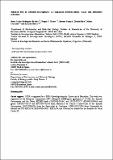Por favor, use este identificador para citar o enlazar a este item:
http://hdl.handle.net/10261/77932COMPARTIR / EXPORTAR:
 SHARE SHARE
 CORE
BASE CORE
BASE
|
|
| Visualizar otros formatos: MARC | Dublin Core | RDF | ORE | MODS | METS | DIDL | DATACITE | |

| Título: | Substrate fate in activated macrophages: A comparison between innate, classic, and alternative activation |
Autor: | Rodríguez-Prados, Juan-Carlos; Través, Paqui G. CSIC; Cuenca, Jimena CSIC; Rico, Daniel CSIC ORCID; Aragonés, Julián; Martín-Sanz, Paloma CSIC ORCID ; Cascante, Marta CSIC ORCID; Boscá, Lisardo CSIC ORCID CVN | Fecha de publicación: | 2010 | Editor: | American Association of Immunologists | Citación: | Journal of Immunology 185(1): 605-614 (2010) | Resumen: | Macrophages play a relevant role ininnate and adaptive immunity depending on the balance of the stimuli received. From an analytical and functional point of view, macrophage stimulation can be segregated into three main modes, as follows: innate, classic, and alternative pathways. These differential activations result in the expression of specific sets of genes involved in the release of pro-or anti-inflammatory stimuli. In the present work, we have analyzed whether specific metabolic patterns depend on the signaling pathway activated. A[1,2-13C2]glucose tracer-based metabolomics approach has been used to characterize the metabolic flux distributions in macrophages stimulated through the classic, innate, and alternative pathways. Using this methodology combined with mass isotopomer distribution analysis of the new formed metabolites, the data show that activated macrophages are essentially glycolytic cells, and a clear cut off between the classic/innate activation and the alternative pathway exists. Interestingly, macrophage activation through LPS/IFN-γ or TLR-2, -3, -4, and -9 results in similar flux distribution patterns regardless of the pathway activated. However, stimulation through the alternative pathway has minor metabolic effects. Themolecular basis of the differences between these two types of behavior involves a switch in the expression of 6-phosphofructo-2-kinase/fructose-2,6- bisphosphatase (PFK2) from the liver type-PFK2 to the more active ubiquitous PFK2 isoenzyme, which responds to Hif-1α activation and increases fructose-2,6-bisphosphate concentration and the glycolytic flux. However, using macrophages targeted for Hif-1α, the switch of PFK2 isoenzymes still occurs in LPS/IFN-γ-activated macrophages, suggesting that this pathway regulates ubiquitous PFK2 expression through Hif-1a-independent mechanisms. Copyright © 2010 by The American Association of Immunologists, Inc. | Descripción: | El pdf del artículo es la versión post-print. | Versión del editor: | http://dx.doi.org/10.4049/jimmunol.0901698 | URI: | http://hdl.handle.net/10261/77932 | DOI: | 10.4049/jimmunol.0901698 | Identificadores: | doi: 10.4049/jimmunol.0901698 issn: 0022-1767 e-issn: 1550-6606 |
| Aparece en las colecciones: | (IIBM) Artículos |
Ficheros en este ítem:
| Fichero | Descripción | Tamaño | Formato | |
|---|---|---|---|---|
| Substrate fate.pdf | 840,92 kB | Adobe PDF |  Visualizar/Abrir |
CORE Recommender
SCOPUSTM
Citations
743
checked on 20-abr-2024
WEB OF SCIENCETM
Citations
703
checked on 15-feb-2024
Page view(s)
690
checked on 22-abr-2024
Download(s)
688
checked on 22-abr-2024
Google ScholarTM
Check
Altmetric
Altmetric
NOTA: Los ítems de Digital.CSIC están protegidos por copyright, con todos los derechos reservados, a menos que se indique lo contrario.
